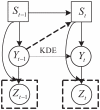Prior knowledge improves decoding of finger flexion from electrocorticographic signals
- PMID: 22144944
- PMCID: PMC3226159
- DOI: 10.3389/fnins.2011.00127
Prior knowledge improves decoding of finger flexion from electrocorticographic signals
Abstract
Brain-computer interfaces (BCIs) use brain signals to convey a user's intent. Some BCI approaches begin by decoding kinematic parameters of movements from brain signals, and then proceed to using these signals, in absence of movements, to allow a user to control an output. Recent results have shown that electrocorticographic (ECoG) recordings from the surface of the brain in humans can give information about kinematic parameters (e.g., hand velocity or finger flexion). The decoding approaches in these studies usually employed classical classification/regression algorithms that derive a linear mapping between brain signals and outputs. However, they typically only incorporate little prior information about the target movement parameter. In this paper, we incorporate prior knowledge using a Bayesian decoding method, and use it to decode finger flexion from ECoG signals. Specifically, we exploit the constraints that govern finger flexion and incorporate these constraints in the construction, structure, and the probabilistic functions of the prior model of a switched non-parametric dynamic system (SNDS). Given a measurement model resulting from a traditional linear regression method, we decoded finger flexion using posterior estimation that combined the prior and measurement models. Our results show that the application of the Bayesian decoding model, which incorporates prior knowledge, improves decoding performance compared to the application of a linear regression model, which does not incorporate prior knowledge. Thus, the results presented in this paper may ultimately lead to neurally controlled hand prostheses with full fine-grained finger articulation.
Keywords: brain–computer interface; decoding algorithm; electrocorticographic; finger flexion; machine learning; prior knowledge.
Figures











Similar articles
-
Decoding Movement From Electrocorticographic Activity: A Review.Front Neuroinform. 2019 Dec 3;13:74. doi: 10.3389/fninf.2019.00074. eCollection 2019. Front Neuroinform. 2019. PMID: 31849632 Free PMC article. Review.
-
Logistic-weighted regression improves decoding of finger flexion from electrocorticographic signals.Annu Int Conf IEEE Eng Med Biol Soc. 2014;2014:2629-32. doi: 10.1109/EMBC.2014.6944162. Annu Int Conf IEEE Eng Med Biol Soc. 2014. PMID: 25570530
-
Decoding Finger Flexion from Band-Specific ECoG Signals in Humans.Front Neurosci. 2012 Jun 28;6:91. doi: 10.3389/fnins.2012.00091. eCollection 2012. Front Neurosci. 2012. PMID: 22754496 Free PMC article.
-
Recording human electrocorticographic (ECoG) signals for neuroscientific research and real-time functional cortical mapping.J Vis Exp. 2012 Jun 26;(64):3993. doi: 10.3791/3993. J Vis Exp. 2012. PMID: 22782131 Free PMC article.
-
From classic motor imagery to complex movement intention decoding: The noninvasive Graz-BCI approach.Prog Brain Res. 2016;228:39-70. doi: 10.1016/bs.pbr.2016.04.017. Epub 2016 May 31. Prog Brain Res. 2016. PMID: 27590965 Review.
Cited by
-
The effects of spatial filtering and artifacts on electrocorticographic signals.J Neural Eng. 2015 Oct;12(5):056008. doi: 10.1088/1741-2560/12/5/056008. Epub 2015 Aug 13. J Neural Eng. 2015. PMID: 26268446 Free PMC article.
-
Characterization of electrocorticogram high-gamma signal in response to varying upper extremity movement velocity.Brain Struct Funct. 2017 Nov;222(8):3705-3748. doi: 10.1007/s00429-017-1429-8. Epub 2017 May 18. Brain Struct Funct. 2017. PMID: 28523425 Free PMC article.
-
Decoding Movement From Electrocorticographic Activity: A Review.Front Neuroinform. 2019 Dec 3;13:74. doi: 10.3389/fninf.2019.00074. eCollection 2019. Front Neuroinform. 2019. PMID: 31849632 Free PMC article. Review.
-
Comparison of decoding resolution of standard and high-density electrocorticogram electrodes.J Neural Eng. 2016 Apr;13(2):026016. doi: 10.1088/1741-2560/13/2/026016. Epub 2016 Feb 9. J Neural Eng. 2016. PMID: 26859341 Free PMC article.
-
Brain-inspired spiking neural networks for decoding and understanding muscle activity and kinematics from electroencephalography signals during hand movements.Sci Rep. 2021 Jan 28;11(1):2486. doi: 10.1038/s41598-021-81805-4. Sci Rep. 2021. PMID: 33510245 Free PMC article.
References
-
- Azzouzi M., Nabney I. T. (1999). “Modelling financial time series with switching state space models,” in Proceedings on IEEE/IAFE 1999 Conference on Computational Intelligence for Financial Engineering, Port Jefferson, NY: Institute of Electrical and Electronics Engineers (IEEE), 240C249
Grants and funding
LinkOut - more resources
Full Text Sources

